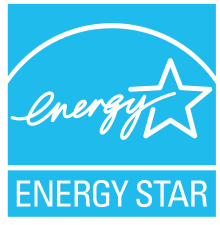Energy Star
Energy Star (spelling: (including) ENERGY STAR ) is a US eco-label for energy-saving devices, construction materials, public / commercial buildings or residential buildings.
The Energy Star certifies z. B. electrical appliances that they meet the US Environmental Protection Agency (EPA ) and US Department of Energy's energy efficiency criteria. An important criterion is that a device that is switched on automatically switches itself back after a while. In the case of computers , the processor performance must be reduced and the hard disk switched off. This standby mode results in very low power consumption . Specification 5.0 stipulates that the screen saver must be switched on after 15 minutes of inactivity at the latest and the idle state in the memory (S3) must be switched on after 30 minutes of inactivity at the latest.
In the IT sector in particular, there are many devices (e.g. PCs , computer monitors , printers , fax machines , copiers , scanners , multifunctional devices ) with this code.
Any manufacturer who believes that their device meets this standard can use the Energy Star . A notification to the EPA or, in the case of office and IT equipment in the European Union (→ EU Energy Star ), a notification to the EU Commission is sufficient . There is no check.
history
The Energy Star has existed since 1992 and was launched by the American environmental protection agency (EPA ). In 2003, the Energy Star was officially introduced in Europe through an EU regulation .
There were some predecessors like the GEEA label of the Group for Energy Efficient Appliances, which dissolved in favor of the Energy Star.
The Energy Star, together with the TCO labels, is the oldest label still in existence that rates computer hardware under Green IT aspects.
Energy Star criteria
- A device / component that is switched on must switch back after a certain time.
- For each device there are criteria for the maximum permissible energy consumption over a certain period of time.
New version for computers
On July 1, 2009, a new version (version 5.0) of the specifications for computers came into force, which provides a new limit value system based on a formula:
- There are no longer any fixed limits per device type. Rather, the limit values are calculated using a differentiated formula.
- The formula consists of a base factor of 8.76, which is calculated with the consumption values in watts for "switched off", "idle state in storage" (S3) and "idle" as well as a "typical" mode of use specified by Energy Star for the device type (e .g . for normal desktop PCs this would be 55% of the time "off", 5% "idle" and 40% "idle" - other numbers apply to laptops or servers).
- In addition, categories are defined, for example according to the number of processor cores or according to whether the computer has a dedicated graphics card.
- The result for the individual computer must not exceed the limit values defined by Energy Star (for a PC with a dual core processor without its own graphics card, for example, the value of 175 kWh per year applies).
- For components that go beyond the basic configuration specified by Energy Star (e.g. more memory), additional values can be added to the limit value (e.g. for every 1 GB memory over 2 GB in PC category B, 1 kWh more than the limit value 175 kWh) .
criticism
The Energy Star label, although it is widespread, is criticized for its very low effectiveness for two reasons: The criteria are too weak and are met by over 70% of the electrical devices on the market, and there are no checks to determine whether the Manufacturers measure their devices correctly and declare them correctly. The rules are not sales regulations, but they are intended to be a seal of approval.
Web links
- www.energystar.gov (English)
- Specifications 5.0 for computers (English; PDF; 377 kB)
- www.eu-energystar.org
- With "80-Plus" power supplies to Energy Star 4.0
- EU Energy Star Regulation (PDF file; 97 kB)
